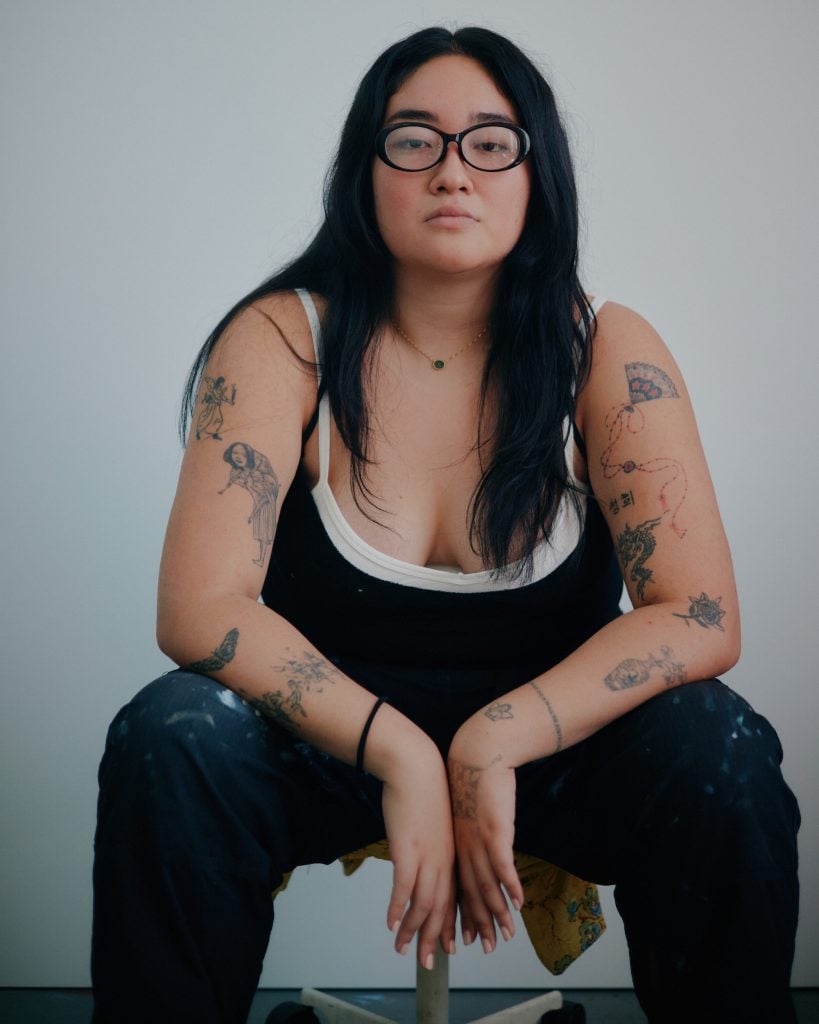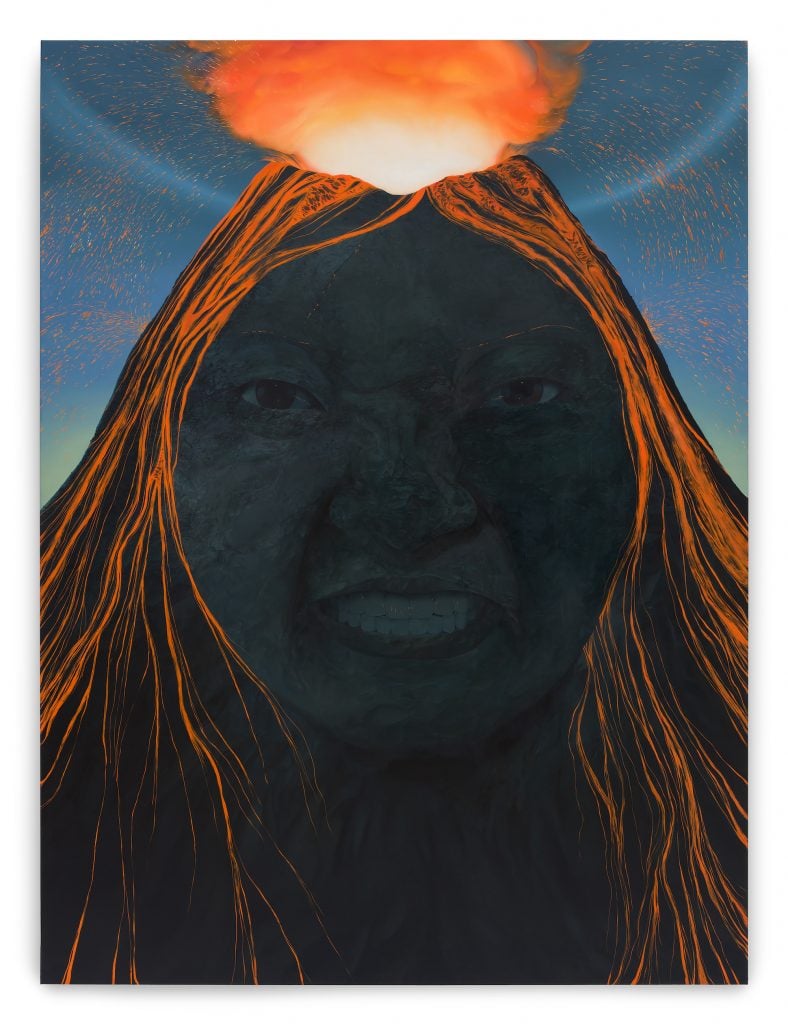Artists
For Her Major Museum Debut, Brooklyn Star Sasha Gordon Paints Hybrid Notions of the Self
The 25-year-old artist spoke to us ahead of the highly anticipated opening of "Surrogate Self" at the ICA Miami.

The 25-year-old artist spoke to us ahead of the highly anticipated opening of "Surrogate Self" at the ICA Miami.

Katie White

“What if I painted myself as a marshmallow? That could be either really stupid or really great,” said Sasha Gordon in her Bushwick studio. The artist was standing in front of a painting of herself as, yes, a marshmallow. Of a small scale and not yet finished, the work struck me as simultaneously cheeky and uncanny.
Gordon’s marshmallow woman wears glasses, her hair is pulled up with twigs in the place of chopsticks, and the hair is slightly scorched. “She’s a kind of sexy librarian character,” she said of the white-on-white figure on canvas. “Flames are going in the corners. I just try to make these as weird as I can. I get frustrated when there isn’t any of that strangeness in a painting.”
Weirdness is one of the cornerstones of the 25-year-old New York painter’s visual world. Among the most sought-after young artists, Gordon is known for her hyper-personal, near-hallucinatory paintings of her doppelgänger. Throughout her compositions, versions of Gordon appear as fickle and fluctuating manifestations marked by a distinct unnaturalness—subjects depicted may have fluorescent skin or traipse through Surrealist nightscapes. These visions are anxious and intimate at once, teetering somewhere between tenderness and night terrors. Her avatars, with their myriad antics, offer Gordon an avenue for exploring contradictory emotions and complex personal experiences.

Sasha Gordon, Concert Mistress (2021). Collection of ICA Miami. Courtesy of the artist and Matthew Brown Gallery.
Gordon has had a lot to process over the past three years, a timespan in which the artist catapulted from painting in her parents’ home in Westchester, New York, to being the subject of blockbuster exhibitions worldwide. Having graduated from the Rhode Island School of Design in 2021 at the height of the pandemic, Gordon suddenly had her career spark off when Jonathan Travis, the go-to art world realtor and savvy collector, reached out to her on Instagram, inquiring about her work. Travis would ultimately introduce the young artist to L.A. gallerist Matthew Brown; her 2021 solo show “Enters Thief” at the gallery ignited much of the art world’s fascination (Gordon is represented by Brown on the West Coast).
Now, Gordon is on the cusp of another major milestone: this week she is opening her debut solo museum exhibition “Surrogate Selves” curated by Alex Gartenfeld at the ICA Miami, coinciding with Art Basel Miami Beach. The exhibition is already promising to be a must-see.
When I visited Gordon in her studio this fall, she was still finalizing the works for the show. Unfinished paintings hung on the studio walls with scenes that hinted at mythology and metamorphosis. Unlike her more narrative tableaux filled with active scenes (as seen in her 2022 Deitch exhibition “Hands of Others”), Gordon’s current series of paintings seemed more self-contained, with often a single figure depicted. Her doppelgängers have themselves become manifestations of hybridity or duality, with their figures appearing to be made of two textures or materials. In-person, her immaculately painted compositions are marvelous and surprising. In one work, a doppelgänger appears dressed in a knight’s armor, but her skin itself transforms to silver—the painting is a captivating and introspective riff on Le Chevalier aux fleurs in Musée d’Orsay in Paris.
Working up to the ICA exhibition, Gordon was balancing enthusiasm with anxiety. “I’m incredibly excited for the opportunity to show these works to the world. But I get nervous for the attention—the actual celebration of the show—even when I’m confident in the works,” she said. She’d be working “until the art handlers arrive,” but noted, with her characteristic sense of humor, that she’d been breaking up her days with “brain melting” TikTok videos, matcha green tea, and the occasional cigarette. “Sometimes, if I get too anxious, I’ll take a nap for an hour and a half. I end up being really productive right after because I feel like I wasted so much time napping.”

Sasha Gordon, Volcano (2023). Copyright Sasha Gordon. Courtesy of the artist; Matthew Brown Gallery, Los Angeles, and Stephen Friedman Gallery. Photo: Mark Blower.
Gordon acknowledges that her paintings are in many ways biographical. Her figures’ frozen moments of metamorphoses can be reflective of her experiences as a queer Asian woman and her inward reckoning and recognition (Gordon’s mother is Korean, her father is Jewish American).
“For a long time, I was not aware of my queerness, but also felt I had to hide parts of myself. It damaged me, I guess. If you repress something, you can forget about it for years, but it’ll somehow come back and it’ll be just as hard to deal with,” she said. In these new works, her avatars tap into the experiences, and alienation, of unconventional beings and bodies, while pricking at these very taboos. “Painting was a way to ignore aspects of myself. I could give myself over to that and not think about other parts of myself. But, now, I’ve found comfort in my queerness. While it was hard to come to that realization, it has answered so many anxieties I had that I couldn’t name.”
In one painting, a woman stands nude on a shoreline at night, holding a conch shell to her ear, listening. Behind the shell, a phantom figure barely visible and nacreous like the inside of a shell, appears whispering. The woman seems discomforted, but not entirely aware of this illusory presence. “She doesn’t know, but also she maybe knows something isn’t right,” said Gordon of the ambiguity of the scene. The moonlight of the scene is echoed in the moons of the woman’s eye. “Many of these works are about transformation and anthropomorphism,” she added.
There is a tension and a lack of resolution in this painterly space between states. For her part, Gordon had just recently moved into a new studio when I visited her. While in the same building she’s been in for several years, her new space is larger and brighter. It has allowed Gordon to scale up her work and allowed her to have more space for more creative possibilities.
“I am allowing in some stillness. I like telling a story without being so direct and right now I’m concentrating on composition over anything else,” she said. “ These don’t need a lot of extra elements. Sometimes, a quiet painting can be even more impactful.”
More Trending Stories:
Art Critic Jerry Saltz Gets Into an Online Skirmish With A.I. Superstar Refik Anadol
Your Go-To Guide to All the Fairs You Can’t Miss During Miami Art Week 2023
The Old Masters of Comedy: See the Hidden Jokes in 5 Dutch Artworks
David Hockney Lights Up London’s Battersea Power Station With Animated Christmas Trees
On Edge Before Miami Basel, the Art World Is Bracing for ‘the Question’
Thieves Stole More Than $1 Million Worth of Parts From an Anselm Kiefer Sculpture